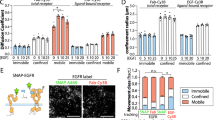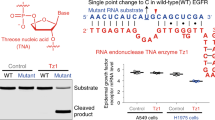Abstract
The receptor for epidermal growth factor (EGF) is a single-chain transmembrane polypeptide of relative molecular mass (Mr) 170,000 (170K) which has been implicated in the regulation of both normal and abnormal cell proliferation1. It has an externally facing EGF-binding domain and a cytoplasmically facing tyrosine-specific protein kinase site. Although the receptor has been well characterized2–4, the mechanism by which it transmits the growth stimulatory signal from the plasma membrane to the nucleus is unclear. EGF binding to cells has been shown to enhance topoisomerase activity within the cells5. Topoisomerases catalyse the interconversion of topological isomers of DNA and thus may influence replication and transcription6. Mroczkowski et al.7 reported that purified EGF receptors of both human and murine origin can nick supercoiled double-stranded (ds) DNA in an ATP-dependent fashion, an activity related to those of topoisomerases6. Another related tyrosine kinase, pp60src, has also been reported to have a similar DNA-nicking activity7. We have now characterized the EGF receptor-associated DNA-nicking activity by sucrose gradient centrifugation. Our results, presented here, indicate that the DNA-nicking activity is not intrinsic to the EGF receptor, but is found in a distinct molecular species.
This is a preview of subscription content, access via your institution
Access options
Subscribe to this journal
Receive 51 print issues and online access
$199.00 per year
only $3.90 per issue
Buy this article
- Purchase on Springer Link
- Instant access to full article PDF
Prices may be subject to local taxes which are calculated during checkout
Similar content being viewed by others
References
Carpenter, G. & Cohen, S. A. Rev. Biochem. 48, 193–216 (1979).
Das, M. et al. Proc. natn. Acad. Sci U.S.A. 74, 2790–2794 (1977).
Cohen, S., Ushiro, H., Stoscheck, C. & Chinkers, M. J. biol. Chem. 257, 1523–1539 (1982).
Ullrich, A. et al. Nature 309, 418–425 (1984).
Miskimins, R., Miskimins, W. K., Bernstein, H. & Shimizu, N. Expl Cell Res. 146, 53–62 (1983).
Gellert, M. A Rev. Biochem. 50, 879–910 (1981).
Mroczkowski, B., Mosig, G. & Cohen, S. Nature 309, 270–273 (1984).
Basu, M., Biswas, R. & Das, M. Nature 311, 477–480 (1984).
Das, M., Knowles, B., Biswas, R. & Bishayee, S. Eur. J. Biochem. 141, 429–434 (1984).
Biswas, R., Basu, M., Sen-Majumdar, A. & Das, M. Biochemistry 24, 3795–3802 (1985).
Tse, Y. C., Kirkegaard, K. & Wang, J. C. J. biol. Chem. 255, 5560–5565 (1980).
Champoux, J. J. J. biol. Chem. 256, 4805–4809 (1981).
Tse-Dinh, Y. C., Wong, T. W. & Goldberg, A. R. Nature 312, 785–786 (1984).
Martin, R. G. & Ames, B. N. J. biol. Chem. 236, 1372–1379 (1961).
Author information
Authors and Affiliations
Rights and permissions
About this article
Cite this article
Basu, M., Frick, K., Sen-Majumdar, A. et al. EGF receptor-associated DNA-nicking activity is due to a Mr-100,000 dissociable protein. Nature 316, 640–641 (1985). https://doi.org/10.1038/316640a0
Received:
Accepted:
Published:
Issue Date:
DOI: https://doi.org/10.1038/316640a0
This article is cited by
-
Translocation of ErbB receptors into the nucleus
Revista de Oncología (2003)
-
Signalling shortcuts: cell-surface receptors in the nucleus?
Nature Reviews Molecular Cell Biology (2002)
Comments
By submitting a comment you agree to abide by our Terms and Community Guidelines. If you find something abusive or that does not comply with our terms or guidelines please flag it as inappropriate.



